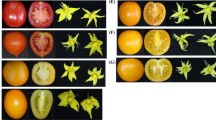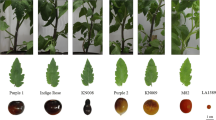Abstract
The tomato (Lycopersicon esculentum) high-pigment (hp) locus was originally described as having enhanced fruit-quality characteristics and has also been shown to regulate responses to light during growth and development. Specifically, the hp phenotype suggests that the normal HP gene-product serves as a negative regulator of light signal-transduction, as has been proposed for many of the previously described Arabidopsis thaliana photomorphogenic mutants. Consequently, hp represents a tool for both genetic dissection of light signal-transduction and manipulation of fruit quality in tomato. As a first step toward isolation of the HP gene, the hp locus was mapped to tomato chromosome 2, adjacent to the 45s rDNA locus, using DNA markers and an interspecific cross of L. esculentum×L. cheesmannii. We have simultaneously identified DNA markers which may be useful for gene isolation and marker-assisted selection. We have additionally extended characterization of the hp phenotype to demonstrate increased sucrose and flavonoid accumulation in ripe hp/hp fruit. Analysis of plastid DNA copy number relative to genomic DNA content indicates that the hp locus regulates plastome DNA concentration, and possibly plastid number, in response to light.
Similar content being viewed by others
Author information
Authors and Affiliations
Additional information
Received: 26 June 1997 / Accepted: 22 July 1997
Rights and permissions
About this article
Cite this article
Yen, H., Shelton, B., Howard, L. et al. The tomato high-pigment (hp) locus maps to chromosome 2 and influences plastome copy number and fruit quality. Theor Appl Genet 95, 1069–1079 (1997). https://doi.org/10.1007/s001220050664
Issue Date:
DOI: https://doi.org/10.1007/s001220050664




